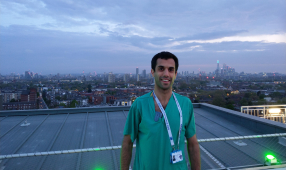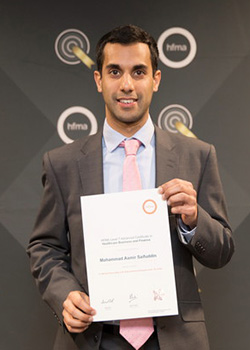Comment / COVID-19: reflections from the front line (part 1)
The Covid-19 pandemic became a major issue very quickly for NHS staff in March this year, leading to a stressful and busy period for those working on the frontline. In a two-part blog, gastroenterology and general medical registrar Aamir Saifuddin provides an insight into his experiences, how it has felt and what he has learnt.
Friday 13 March was the day it all became real. Before this, COVID-19 felt like a figment of imagination. Just something that was on the news and was affecting cruise ships and holidaymakers. People had become wary about shaking hands, but it all seemed very precautionary.
I’d recently completed six months working in the liver unit at King’s College Hospital NHS Foundation Trust in London and had started as a specialist registrar in the gastroenterology department two weeks previously, looking after complex hepatology and gastroenterology inpatients, conducting specialist clinics, and developing skills in gastroscopy and colonoscopy.
Hospital services were continuing as normal and people were talking about Covid simply as a current affairs topic.
But on the 13 March, I felt the atmosphere around the hospital change. In our department, the registrars, consultants and managers met to discuss how our working model might be affected by Covid. News alerts described rising European and British death tolls. The prime minister explained the need to ‘flatten the curve’ so our hospitals wouldn’t be overwhelmed. Medical conferences scheduled for June were being cancelled.
The trust had begun to organise Covid question and answer and clinical simulation sessions. And rumours, though ultimately unfounded, began to circulate about doctors in London who were on life support machines. The stark reality of Covid, as a frontline medic, had hit.
In the subsequent days, as social distancing progressed to lockdown and daily mortality figures for King’s and the UK began to increase, the apprehension heightened. Before this, the most you might ‘catch’ from a patient (barring blood-borne viruses) was a vomiting bug. Now, you might feasibly catch a life-threatening virus that had seemingly already struck colleagues working only miles away.
As the country was told to refrain from non-essential activities to reduce risk, we were doing the exact opposite and traveling to virus hotspots every day, aware that King’s had the most cases in the country initially. We became aware that patients we had reviewed and examined without precautions, who had been previously admitted for other reasons, had tested positive. This brought a nervous wait for our own symptoms potentially to develop.
There was an acute sense that this was going to become an extraordinary few weeks. The roads suddenly emptied overnight. NHS workers were being offered free car parking, free taxi journeys, discounted takeaways and, even, razors to help stubble-free mask-fitting. The Nightingale hospitals were being readied to treat an unfathomable potential surge of thousands of critically unwell patients (for comparison, large London hospitals typically have fewer than 100 critical care beds).
Non-urgent operations, procedures and clinics were cancelled – there would no longer even be the capacity to pursue socially distant video or phone consultations. Doctors, nurses, physios and admin staff were all redeployed to bolster the workforce needed to manage the potential onslaught of sick patients.
Many hadn’t worked on a medical ward for several years and were worried about how they’d cope with unwell Covid patients. The A&E department was divided into ‘clean’ and ‘dirty’ sections. Feats of logistics and innovation increased intensive care capacity and wards became assigned as ‘Covid wards,’ including mine.
Simulation sessions were run for all staff, explaining how to use personal protective equipment (PPE) properly and how to deal with a Covid cardiac arrest. The alien concept of not performing immediate chest compressions if a patient had arrested needed to be drilled in – the risk of virus being expelled from the chest is too high unless everyone in the room is wearing full PPE. A nurse or doctor might find a patient suddenly not breathing and, harrowingly, have to leave to put on their own protective equipment before being able to help.
During this already highly stressful scenario, specific care would also need to be taken when passing equipment in and out of the room to minimise the risk of contamination. There was a constant fear about what ‘the peak’ might look like.
We all envisaged scenes like those from Spain and Italy on the news: patients with breathing tubes and ventilators in corridors and car parks, A&E and intensive care departments bursting at the seams, physically and mentally exhausted doctors and nurses wondering when they might get some proper rest, and doctors needing to choose which patients would be allocated the limited ventilators.
Everyone kept wondering if we were in ‘the calm before the storm.’ It was genuinely scary to think that might be us in the weeks to come.
Luckily, the storm has, currently, been avoided. The various curve-flattening interventions seem to have achieved their primary aim of maintaining the NHS’s intensive care and ward capacity. While we’ve clearly been very busy and intensive treatment units have been filled to the brim, the horrors of other countries haven’t been replicated. So, while the numbers of deaths are tragic, this seems to be because of the virulence of the infection itself rather than because individuals haven’t received the best possible medical care.
I was a registrar (the level below consultant) working on a ward that was turned into a Covid ward and admitted Covid patients from A&E for over two months, and I had the chance to reflect while in the middle of this.
Medicine is unwaveringly fascinating. Unfortunately, this fascination brings with it illness and death, which is part of our daily medical lives. However, it also brings treatment, recovery, a privileged glimpse into people’s lives when at their most vulnerable. And it produces unparalleled gratitude, which is why we love doing it and why it’s the best job in the world. This fascination also means we are constantly learning and reflecting and are able to improve outcomes for future patients.
My first reflection is how interesting it has been to treat patients with a brand new disease. Generally in medicine, experience counts for everything. The more experience you have, the more honed are your diagnostic skills and understanding of the nuances of treatment. But everyone is now learning from the same starting point, picking up information from the news, journals, their own day-to-day experiences and the experiences of others.
A crucial part of this is deciphering when a patient with new fever, cough or breathlessness has Covid, or heart failure, or a clot in the lung, or another infection, for example – all have very different, and sometimes opposing, treatments.
We began to appreciate that some patients, particularly the elderly, may have none of these ‘classic’ symptoms. They may simply be more drowsy or ‘off their food’, for which the differential diagnosis was already huge, but life-threatening COVID was now possible.
Early on, around the NHS, there will have been misdiagnoses, with biases towards Covid at the expense of other conditions. Unfortunately in medicine, mistakes can be catastrophic, but subsequent learning aims to prevent recurrence. Some of the initial thoughts about how to treat very unwell patients with Covid have entirely changed based on experience – how much intravenous fluid to give, how to optimally use ventilators, understanding how patients develop clots.
These patients also deteriorate rapidly, talking to you comfortably in the morning then needing a ventilator by lunchtime. It has been an intriguing process as everyone from the most junior doctors to senior consultants can update their colleagues about something new they’ve learnt the previous evening that can help patients the following day.
We have looked after a range of patients on our ward, including a woman in her late 20s who was stable the day before and then quickly became unable to breathe properly while we were reviewing her on the morning ward round. I’d not been ‘scared’ by a patient for some years, but this was quite early on in the pandemic and I had no idea how quickly she might further deteriorate.
Seeing her oxygen levels worsen in front of our eyes was terrifying. Luckily, we were able to treat her on the ward instead of transferring for a ventilator. We also cared for quite elderly people, some of whom improved, some of whom unfortunately didn’t. Many of these patients had also suffered recent Covid-related bereavements, often of male spouses. We did manage to discharge home a 95 year-old Afro-Caribbean woman with dementia, which seems a triumph in retrospect.
Read Dr Saifuddin’s further reflections on his Covid experience to date next week in Healthcare Finance weekly
Dr Saifuddin is a recent graduate of the HFMA advanced qualifications programme in healthcare business and finance (pictured above)
Related content
The Institute’s annual costing conference provides the NHS with the latest developments and guidance in NHS costing.
The value masterclass shares examples of organisations and systems that have pursued a value-driven approach and the results they have achieved.